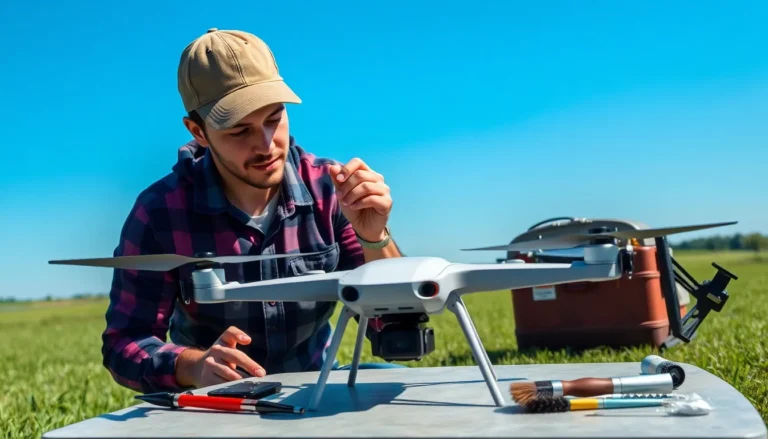Drones are the high-flying marvels of modern technology, but like any gadget, they need a little TLC to keep soaring. Imagine sending your trusty drone into the wild blue yonder only to have it crash-land because of a tiny oversight. Not cool, right? Keeping your drone in tip-top shape isn’t just smart; it’s essential for avoiding those embarrassing “oops” moments.
Table of Contents
ToggleImportance Of Drone Maintenance
Maintaining drones ensures they operate efficiently and safely. Regular inspection of components minimizes the risk of technical failures during flight. Preventative care protects against common issues such as motor malfunctions and battery degradation.
Battery health plays a crucial role in flight duration and performance. Inspecting battery terminals for corrosion enhances longevity and prevents electrical failures. Keeping batteries charged according to manufacturer recommendations prolongs their lifespan.
Cleaning the drone after every flight contributes to its functionality. Removing dirt and debris from sensors and propellers enhances flight stability. Clogged sensors can lead to navigational errors, so thorough cleaning is essential.
Firmware updates provide improved performance and new features. Regularly checking for updates ensures access to the latest advancements in drone technology. Compatibility with the newest software can significantly enhance operational capabilities.
Calibrating sensors is vital before each flight. This process aligns the drone’s navigation system with real-world conditions, resulting in better accuracy. Failing to calibrate can lead to unpredictable flight paths and increased crash risk.
Tracking maintenance schedules aids in identifying routine tasks. Organizing tasks like blade inspections and body checks on a calendar ensures nothing is overlooked. Consistency in maintenance fosters reliability, leading to enhanced overall performance.
Adopting these maintenance practices keeps drones in optimal working condition. Prioritizing upkeep leads to fewer repairs and extends the life of the equipment. Investing time in maintenance reflects a commitment to safety and efficiency in drone operations.
Regular Inspection Procedures

Regular inspections play a vital role in drone maintenance. They ensure optimal performance and safety during flights.
Battery Checks
Battery health significantly affects a drone’s performance. Inspect batteries for physical damage or swelling. Clean the battery terminals with a cotton swab to prevent corrosion. Charge batteries according to the manufacturer’s recommendations. Maintaining a consistent charge level extends battery life. Monitor battery voltage and replace any cells showing lower capabilities. Operators should follow proper storage conditions to preserve battery efficiency. Keeping batteries dry and at appropriate temperatures promotes longevity.
Propeller Assessment
Propellers require thorough checks for optimal flight operations. Examine propellers for cracks, chips, or warping. Ensure they’re securely attached and free of debris. A balanced propeller improves flight stability and reduces stress on the motors. Replace damaged propellers promptly to avoid dangerous situations. Regularly cleaning propellers enhances performance by minimizing drag. Operators need to conduct these assessments before every flight. Addressing propeller issues prevents significant technical failures during operation.
Cleaning Your Drone
Cleaning your drone plays a critical role in maintaining its performance. It prevents dirt buildup and ensures sensors remain unobstructed.
Recommended Cleaning Supplies
Use a microfiber cloth for sensitive surfaces. Isopropyl alcohol effectively removes stubborn stains. Compressed air helps dislodge debris from hard-to-reach areas. A soft brush can safely clean propellers and motors without causing damage. Always keep these supplies readily available for post-flight maintenance.
Step-By-Step Cleaning Process
Start by powering off the drone and removing the battery. Remove the propellers to clean them separately. Wipe the exterior with a microfiber cloth dampened in isopropyl alcohol. Use compressed air to blow out dust from the camera and sensors. Clean the propellers with a soft brush and inspect for damage. Finally, reattach the propellers and insert the battery, ensuring everything is secure before the next flight.
Software Maintenance
Software maintenance plays a crucial role in maximizing a drone’s potential and safety during operations. Regular attention to software aspects ensures the best performance and reliability.
Firmware Updates
Firmware updates enhance performance and introduce new features. Users must check for updates regularly, as manufacturers often release them to fix bugs or improve functionality. Applying updates can optimize flight performance and ensure compatibility with the latest technologies. Ignoring these updates may lead to suboptimal operations or even malfunctions. Therefore, operators should enable automatic updates whenever possible or set reminders to check for them routinely.
Calibration Procedures
Calibration procedures ensure accurate sensor readings and optimal flight performance. Drones often require calibration after changes in environmental conditions or after transport. Operators should consult the manufacturer’s guidelines to find specific calibration steps. Each calibration typically involves leveling the drone and adjusting GPS settings to ensure accuracy. Performing these procedures before each flight helps maintain reliability, resulting in smoother operation and precise control. Neglecting calibration can lead to navigational errors, risking safety and performance.
Storing Your Drone
Proper storage of a drone plays a crucial role in its longevity and performance. Operators must store drones in a cool, dry environment to prevent issues related to humidity and heat. Humidity can lead to corrosion of sensitive electronic components. Heat can damage batteries, reducing their overall lifespan.
Use a dedicated case for storage to protect the drone from dust and physical impacts. Such cases should include compartments for batteries and accessories. Consider removing the battery when storing, as this helps preserve battery health and prevents accidental activation.
Ensure that the drone’s propellers are protected during storage. Using propeller guards or placing the drone in a case keeps blades safe from damage. Keeping propellers in good condition aids in optimal flight performance.
Regularly check stored drones for signs of wear, corrosion, or damage. Inspections should include visual assessments of all components, including the frame, motors, and sensors. Addressing any issues promptly can prevent more significant problems later.
Use specific storage solutions tailored to the drone model for optimal results. For example, branded storage pockets or bags can offer additional protection and better organization. Optimal storage also considers the nearby environment; avoid placing the drone near sources of moisture or direct sunlight.
By adopting these storage tips, drone operators can extend the lifespan of their equipment and ensure readiness for future flights. Prioritizing proper storage safeguards investment and enhances overall performance.
Maintaining a drone is essential for ensuring its longevity and optimal performance. By following these maintenance tips, operators can significantly reduce the risk of technical failures and enhance flight safety. Regular inspections and timely battery checks play a crucial role in preventing mishaps.
Cleaning the drone after each flight keeps sensors clear and functioning properly. Additionally, staying updated with firmware and calibrating sensors before each flight maximizes performance and accuracy. Proper storage is equally important for protecting the drone from environmental factors.
By implementing these practices, drone operators can enjoy a reliable and efficient flying experience while demonstrating their commitment to safety.










